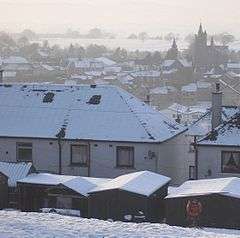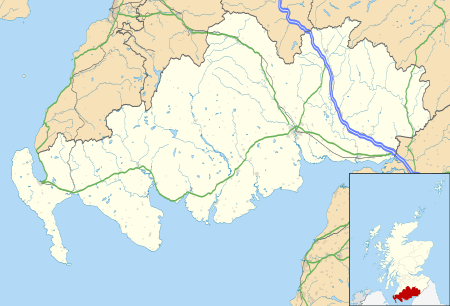Lockerbie
| Lockerbie | |
| Scottish Gaelic: Locarbaidh | |
 East Lockerbie in December 2009 |
|
 Lockerbie |
|
| Population | 4,009 (Census 2001) |
|---|---|
| OS grid reference | NY135815 |
| Council area | Dumfries and Galloway |
| Lieutenancy area | Dumfriesshire |
| Country | Scotland |
| Sovereign state | United Kingdom |
| Post town | LOCKERBIE |
| Postcode district | DG11 |
| Dialling code | 01576 |
| Police | Scottish |
| Fire | Scottish |
| Ambulance | Scottish |
| EU Parliament | Scotland |
| UK Parliament | Dumfriesshire, Clydesdale and Tweeddale |
| Scottish Parliament | Dumfriesshire |
Coordinates: 55°07′12″N 3°21′25″W / 55.120°N 3.357°W
Lockerbie (Scottish Gaelic: Locarbaidh[1]) is a town in Dumfries and Galloway, south-western Scotland. It lies approximately 75 miles (121 km) from Glasgow, and 20 miles (32 km) from the English border. It had a population of 4,009 at the 2001 census. The town came to international attention in December 1988 when the wreckage of Pan Am Flight 103 crashed there following a terrorist bomb attack aboard the flight.
History
Lockerbie apparently has existed since at least the days of Viking influence in this part of Scotland in the period around AD 900. The name (originally "Loc-hard's by") means Lockard's Town in Old Norse. The presence of the remains of a Roman camp a mile to the west of the town suggests its origins may be even earlier. Lockerbie first entered recorded history in the 1190s in a charter of Robert de Brus, 2nd Lord of Annandale, granting the lands of Lockerbie to Adam de Carlyle.[2] It appears as Lokardebi, in 1306.
Lockerbie's main period of growth started in 1730 when the landowners, the Johnstone family, made plots of land available along the line of the High Street, producing in effect a semi-planned settlement. By 1750 Lockerbie had become a significant town, and from the 1780s it was a staging post on the carriage route from Glasgow to London.
Perhaps the most important period of growth was during the 19th century. Thomas Telford's Carlisle-to-Glasgow road was built through Lockerbie from 1816. The Caledonian Railway opened the line from Carlisle to Beattock through Lockerbie in 1847 and later all the way to Glasgow. From 1863 until 1966 Lockerbie was also a railway junction, serving a branch line to Dumfries. Known as the Dumfries, Lochmaben and Lockerbie Railway, it was closed to passengers in 1952 and to freight in 1966.
Lockerbie had been home to Scotland's largest lamb market since the 18th century but the arrival of the Caledonian Railway increased further its role in the cross-border trade in sheep. The railway also produced a lowering in the price of coal, allowing a gas works to be built in the town in 1855.

Architecture
Much of Lockerbie is built from red sandstone. There are several imposing buildings near the centre, none more so than the Town Hall, finished in 1880, complete with its clock tower.
A little to the north of the centre is the Dryfesdale Parish Church, with its brightly decorated interior. The name Dryfesdale comes from the local river, the Dryfe Water, which joins the River Annan a little to the west of the town. Less well known and a mile and a half south of Lockerbie is the Ukrainian Chapel at the old Hallmuir Prisoner of War Camp.
The town is served by Lockerbie railway station.
Pan Am 103 bombing
Lockerbie is known internationally as the place where, on 21 December 1988, the wreckage of Pan Am Flight 103 crashed after a terrorist bomb on board detonated. In the United Kingdom, the event is often referred to as the Lockerbie disaster, the Lockerbie bombing, or just Lockerbie. Eleven residents of the town were killed in Sherwood Crescent, where the aircraft's wings and fuel tanks plummeted in a fiery explosion, destroying several houses and leaving a large crater, with debris causing damage to a number of other buildings nearby. All 259 people on the flight also died. The 270 total victims were citizens of 20 different nations. The event was and remains to date the deadliest terrorist attack and aviation disaster to have happened on British soil.
Lockerbie Academy
Lockerbie Academy, the town's public high school, became the headquarters for the response and recovery effort after the Pan Am Flight 103 disaster. Subsequently, the academy, in cooperation with Syracuse University of Syracuse, New York, USA, which lost 35 students in the bombing, established a scholarship at the university for two of its most outstanding graduating students. Each year, two graduating students spend one academic year at Syracuse University as Lockerbie Scholars before they begin their university study. The scholarships have led to a lasting relationship between the university and the town. The rector of Lockerbie Academy, Graham Herbert, was recognised in November 2003 at Syracuse University with the Chancellor's Medal for outstanding service.
A former student of the Academy, Helen Jones, was killed in the 7 July 2005 London bombings. In her memory, a new scholarship was set up, awarding £1000 towards further education to aspiring accounting students from the Academy.[3]
Dryfesdale Lodge Visitors' Centre
Dryfesdale Lodge Visitors' Centre,[4] formerly a cemetery worker's cottage, was opened on 25 October 2003 after extensive renovation work funded by the Lockerbie Trust and is maintained with grant assistance from Dumfries & Galloway Council. There are two exhibition rooms in the Lodge and also the Dryfesdale Room that is used as a quiet room for visitors to reflect. A permanent exhibition room displays ten history panels depicting Lockerbie's past stretching from its prehistoric origins to 1988's terrorist attack and beyond. In the cemetery grounds, just a short walk away, is the Lockerbie Memorial Garden of Remembrance.
Dryfesdale Lodge Visitors' Centre has had over 30,000 visitors from home and abroad.
Hallmuir Prisoner of War Camp
About 1.5 miles (2.4 km) south of Lockerbie along the C92 road to Dalton are the remains of Hallmuir prisoner-of-war camp.[5] After the Second World War, this camp housed Ukrainian soldiers from the Galician Division of the Waffen SS. They built a chapel from converted army hut. It was listed in 2003 as a Category B building.[6] The chapel remains in use, currently holding Ukrainian services on the first Sunday of every alternate month.
Lockerbie Drama Club

Lockerbie Drama Club was formed before the Second World War by members of local churches. Originally known as Lockerbie Churches Drama Club, plays were performed in the town hall. In 1964 the club acquired land at the corner of Well Street and Well Road, along with a prefab corrugated iron building that had been a workshop in the Technical department at Lockerbie Academy. This building became Lockerbie Little Theatre.[7] Lockerbie Drama Club puts on two plays per year and holds play readings during the summer.[7]
Lockerbie Ice Rink
Located across the road from Lockerbie Academy, Lockerbie Ice Rink was built in 1966 and is one of the oldest indoor ice rinks in the country. In curling it has given rise to World and European Champions and Olympians in the adult, senior and junior disciplines. It also provides skating during most weekends. The ice rink is closed between April and September.
Sport
The town's senior football club is Mid-Annandale, who compete in the South of Scotland Football League. The club play at King Edward Park, however due to ground criteria they presently play their home fixtures at Galabank in Annan.
Lockerbie House
Lockerbie House was built in 1814 for Sir William Douglas, 4th Baronet of Kelhead and Dame Grace Johnstone and their children; Mary, Henry Alexander, William Robert Keith Douglas, Charles Douglas, 6th Marquess of Queensberry and John Douglas, 7th Marquess of Queensberry. It was inhabited at one time by several different members of the Douglas family through the generations. Such family members include both Archibald Douglas, 8th Marquis of Queensberry PC (son of John Douglas) and his wife Caroline Margaret Clayton (daughter of General Sir William Robert Clayton MP) and their children British mountaineer Lord Francis William Bouverie Douglas, Lady Gertrude Georgiana Douglas, John Sholto Douglas, Viscount Drumlanrig and later the 9th Marquess of Queensberry, Clergyman Lord Archibald Edward Douglas and the twins Lord James Douglas and Lady Florence Dixie (who married Sir Alexander Beaumont Churchill Dixie, 11th Baronet.) John Sholto Douglas was a patron of sport and a noted boxing enthusiast. In 1866 he was one of the founders of the Amateur Athletic Club, now the Amateur Athletic Association of England. The following year the club published a set of twelve rules for conducting boxing matches. The rules had been drawn up by John Graham Chambers but appeared under Queensberry's sponsorship and are universally known as the "Marquess of Queensberry rules". It is thought that such rules were created within the compounds of Lockerbie House, possibly within the room now known as "The Queensbury Dining Room". It is also thought that at one point Oscar Wilde may have also stayed here for a short amount of time due to his affair with John Sholto Douglas's son the author and poet Lord Alfred Bruce Douglas.
Lockerbie House is an important establishment within Lockerbie, in the past having owned most of the land and housing within the town mainly through the Johnstone Baronets and Douglas family. Like much of Lockerbie this Georgian house is built of old red sandstone and contains approx. 40 bedrooms, situated within 78 acres (320,000 m2) of secluded woodland and gardens, several outbuildings including a gatehouse, a 2-acre (8,100 m2) walled garden, croquet lawn, orchards, helipad and a hunting dog pen. The property up until recently also possessed a large stable block but that has since been partly converted into a house with the remaining stables used by a local riding school. Due to the vast size of the property it has frequently been used as a county house hotel in order to help pay for its maintenance and/or provide a prosperous business. The house is now owned by outdoor pursuits company Manor Adventure, and serves as a centre for school activity courses and family adventure holidays.[8]
Battle of Dryfe Sands
About 3 kilometres to the west of Lockerbie on 7 December 1593, Clan Johnstone fought Clan Maxwell at the Battle of Dryfe Sands. The Johnstones nearly exterminated the Maxwells involved in the battle, leading to the proverbial expression "Lockerbie Lick."[9]
See also
References
- ↑ Ainmean-Àite na h-Alba
- ↑
- ↑ Deborah Haynes and David Robertson 16 May 2011 12:01 am. "Helen Jones' scholarship". The Times. UK. Retrieved 16 May 2011.
- ↑ Dryfesdale Lodge Visitors Centre Trust. "Dryfesdale Lodge Visitors Centre". Dryfesdalelodge.org.uk. Retrieved 16 May 2011.
- ↑ "Description of Hallmuir POW camp". Allaboutlockerbie.com. Retrieved 16 May 2011.
- ↑ Historic Scotland 49592
- 1 2 "Lockerbie Drama Club". Lockerbie Drama Club. Retrieved 16 May 2011.
- ↑ "Lockerbie Manor, Dumfries and Galloway Scotland". Lockerbiemanor.co.uk. Retrieved 16 May 2011.
- ↑ "Battle of Dryfe Sands" (PDF). Retrieved 25 July 2012.
External links
| Wikimedia Commons has media related to Lockerbie. |
| Wikisource has the text of the 1911 Encyclopædia Britannica article Lockerbie. |
- Lockerbie Trial Web Site of the UN-appointed observer Dr. Hans Köchler
- The Dryfesdale Lodge Visitors' Centre Website
- A List of the Lockerbie Scholars at Syracuse University
- VisitScotand entry for the Ukrainian POW Chapel
- Lockerbie Academy Website
| ||||||||||||||||||